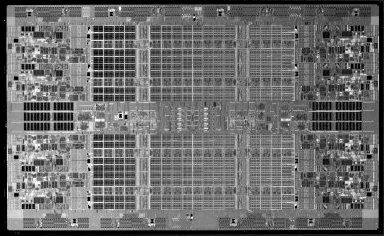
In a world of survival of the fittest coupled with mutations, something always has to be the last of its kind. And so it is with the “Kittson” Itanium 9700 processors, which Intel quietly released earlier this month and which will mostly see action in the last of the Integrity line of midrange and high-end systems from Hewlett Packard Enterprise.
The Itanium line has a complex history, perhaps fitting for a computing architecture that was evolving from the 32-bit X86 architecture inside of Intel and that was taken in a much more experimental and bold direction when the aspiring server chip giant partnered with the old Hewlett Packard to merge some its best ideas about very long instruction word (VLIW) and explicit parallelism (EPIC) in its future PA-RISC chips into Intel’s future silicon. This was the 1990s, when the datacenter was undergoing explosive growth and dramatic transformation, when Sun Microsystems ruled the Unix space that dominated transaction processing, and when AMD was just starting to think about getting into the server racket with the extended memory architecture embodied in its “Hammer” Opteron processors. The server space was a lot less homogenous then than it is now, and it was a lot smaller market, too. So the risks that chip makers took were proportionately bigger but at the same time the options seemed to be wider.
Ironically, in some ways, it is much harder to break into the datacenter today with a server chip then it was two decades ago. The X86 architecture utterly dominates compute, and has a pretty strong hand in storage, too, and some play in virtualized networking. The ecosystem of compute was much more diverse back in the early commercial Internet era, but the hyperscaling of the Web, the maturity of the Windows Server and Linux platforms, and the intense competition from Intel made the X86 architecture – and to be specific, the Xeon species – supreme in the glass house.
This was precisely what Intel had hoped with Itanium, much as it had hoped for the InfiniBand interconnect it developed with IBM as a replacement for a hodge podge of Ethernet, PCI-Express, and other technologies for lashing together client, server, and storage devices. HP started development on the ideas of EPIC back in 1989 as it was clear that its PA-RISC line was going to run out of gas. EPIC was a kind of software-defined chip, to use a modern metaphor, that was designed to make the parallelism in code explicit and have it handled by the compilers instead of various kinds of circuits on the chip. This sounded great on paper, but the amount of explicitly parallel code in enterprise applications was a lot lower back then than it is now. In 1994, HP and Intel formed the Itanium chip partnership, and a year later the RISC/Unix crowd were all starting to commit to porting their operating systems to Itanium because this all seemed so inevitable. The projections certainly made it look this way, and as Itanium chips were delayed and the reality of an extended 64-bit memory addressing for the X86 architecture started sinking in, and then was delivered by AMD in 2003 and copied by Intel the following year, the die was pretty much cast for Itanium. The chip was relegated to fat NUMA servers and database and middleware applications that had been running on RISC/Unix boxes.
This famous Itanium server revenue forecast on Wikipedia encapsulates the enthusiasm for the chip and its deflation rather brilliantly:
The Itanium chip might have given Intel much grief, but it is through difficult and sometimes failed projects that companies learn. IBM has had many failed projects – the Stretch system from the 1950s and the Future Systems follow-on in the 1970s are but two. While Itanium never did take over the PC and server rackets, it did carve out its niche and it probably paid for itself. Itanium did, however, cause Intel a certain amount of public relations heartburn and did leave the door open for AMD’s Opteron to shoot the gap between 32-bit Xeons and 64-bit Itaniums.
In 2009, when Intel put out the “Nehalem” Xeon 5500 processors that basically cloned the Opteron’s architecture, Kirk Skaugen, who ran Intel’s Data Center Group and who now runs the Enterprise Group at Lenovo, said that based on IDC data, the Xeon processors drove about $22 billion in server revenues, with Intel taking in about $4.4 billion of that in chip and chipset sales. Itanium servers accounted for $4 billion in sales, we estimated that Intel got about $1 billion of that for chips and chipsets. AMD’s Opterons, if you can believe it, drove another $3 billion in server sales, leaving $16 billion spent for mainframes, RISC/Unix, and a smattering of proprietary midrange gear. By the time Intel got Itanium working reasonably well, it had changed its roadmaps and delayed processors several times and then Oracle dropped the bomb in 2011, saying it would no longer support its software on Itanium, leaving Intel and HP to defend Itaniums honor and touching off a lawsuit between Oracle and HP in 2012. Oracle had a point. AIX and Solaris never made it to Itanium, Red Hat Enterprise Linux was pulled off the platform in December 2009, and Microsoft pulled the plug on Windows Server and SQL Server in April 2010. But just the same, Oracle lost the suit and rebooted its support on HP-UX Unix on Itanium.
During the course of the Itanium trial, we learned all kinds of things. HP started a port of HP-UX to X86 chips and was even working on a big, fat NUMA machine based on AMD Opteron processors, and then spiked it. These were part of a much broader effort called Project Kinetic, which would eventually see systems that had sockets common to Xeon E7 and Itanium processors. This common socket strategy was set for the “Kittson” generation of Itanium chips, and revealed when the eight-core “Poulson” Itanium 9500 processors were launched in November 2012. This was a year after HP launched “Project Odyssey,” which brought Xeon processor blades to the Superdome NUMA systems that heretofore had been Itanium boxes running HP-UX, NonStop, and OpenVMS platforms. Intel nixed the Xeon-Itanium convergence once and for all in February 2013 – and it was not the first time it had planned this. The common socket idea had been whispered about since 2003, when the Opterons first came out. It was then, in 2013, that the Itanium roadmap was changed, and what was supposed to be a process shrink for Kittson from 22 nanometers to 14 nanometers – the same processes used for the “Broadwell” and “Skylake” Xeons, because a hold steady at 22 nanometers. This means, in essence, that Kittson Itaniums are really just a Poulson+ if you want to be more accurate.
In any event, an Intel spokesperson has confirmed to us what we long suspected, and that is that the Itanium 9700, as this chip is called, is the last of the Itanium line. Here is how the Kittsons stack up to the prior Poulson and Tukwila Itaniums:
As you can see, the Poulsons are really a deep bin sort of the Poulsons, with the Turbo Boost overclocking enabled. This is not really a tick or a tock, in the Intel parlance. But if HPE is not making a fuss about what HP and its customers were promised so many years ago, it doesn’t much matter.
What HPE customers care about is that they have a new processor with some performance advantages, however minor, and continuing support for their large and midrange NUMA boxes. With NVM-Express flash added to the HPE Integrity server platforms, doubling up of the main memory capacity (to 8 TB in a 32-socket Superdome system), and other tweaks in the HP-UX operating system, customers can expect to see around a 30 percent performance boost if they upgrade to the Itanium 9700 chips. By the way, Jeff Kyle, director of product management for Enterprise Servers at HPE, says that HPE will be adding support of Intel’s Optane 3D XPoint memory to the Integrity i6 line using the Itanium 9700s, and that it will be supporting the Itanium-based HP-UX platform on Itanium at least until 2025.
Perhaps more interestingly, HPE is working on porting HP-UX to run atop Linux containers on regular ProLiant Xeon servers. The company has some experience in running emulated environments. Its “Aries” emulation environment from many years ago allowed HP-UX binaries compiled for its PA-RISC processors to run atop Itanium chips.
In the end, HP-UX will end up being just another Linux application, even if it is a fat one wrapped around a database and application servers. In fact, we would not be surprised if many HP-UX shops forego the Itanium 9700 upgrade and wait for these containers running on Xeon Skylake or kicker systems.

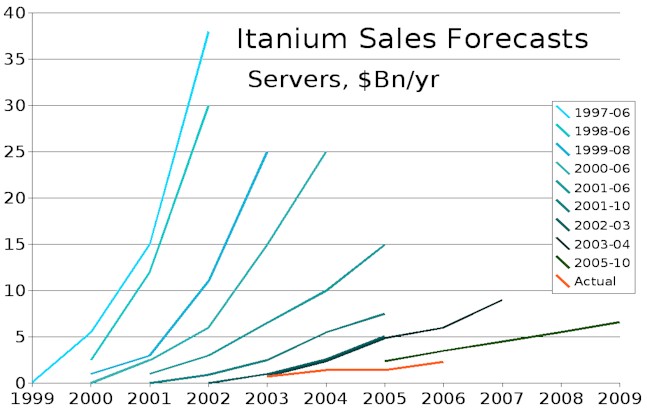
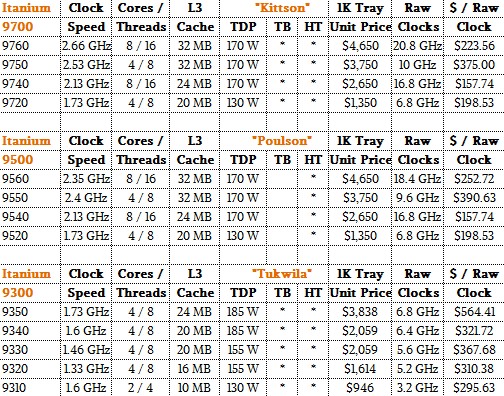
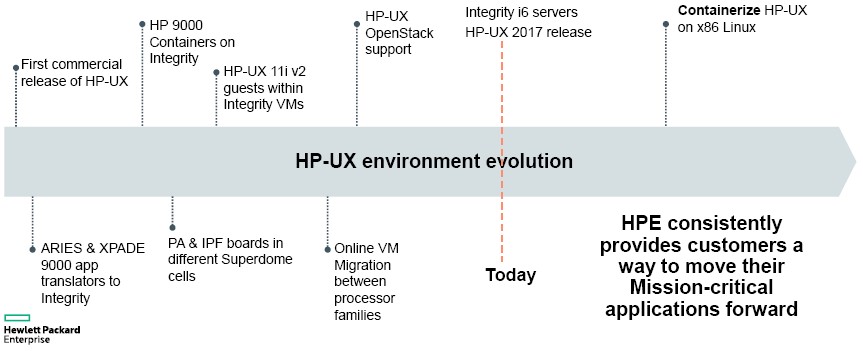

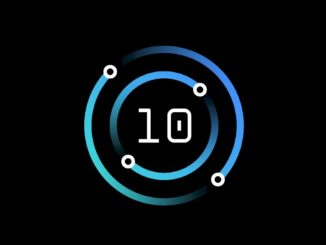


Actually the common socket strategy was planned well before even 2003. “The Pentium Chronicles” talks about it being a thought and plan even in the mid 90s but what happened was the bus teams from the various cpu projects suffered from Not Invented Here syndrome.
Poulson (9500) and Kittson (9700) are both fabricated in a 32 nm semiconductor process, not 22 nm.